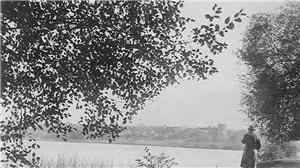In the winter of 1936, a major, WPA-funded cleanup of Seattle's Green Lake is undertaken. For decades, the lake has been subject to algae bloom and outbreaks of green scum and foul odor, and swimmers have gotten swimmer's itch. The massive project includes dredging the lake, building an island (Swan Island, or Duck Island) as a wildlife sanctuary, and building a water-aerating fountain in the middle of the lake. The fountain is never built, but other parts of the project are carried out.
1930s Plan Envisioned Clear Water, an Island, and a Fountain
Attempts to solve the problems of algae bloom and green scum at Green Lake have usually involved chemical solutions and dredging of bottom sediment, yet more imaginative visions have also affected Green Lake's history. Perhaps no effort was as creative and extensive as that attempted during the Great Depression, when the city used federal funds in a large-scale attempt to purify the water of Green Lake once and for all.
By 1935, Green Lake was turning into a malignant disease-breeding menace to health, according to the editor of the Green Lake Reporter. In response, Seattle sanitation engineer, E. French Chase, wrote a proposal to improve Green Lake Park and submitted it to the Works Progress Administration (WPA). Created under Franklin D. Roosevelt's New Deal, the WPA pumped money into public works projects, creating jobs for millions of workers. The city of Seattle received $2.2 million of WPA funding to enhance its parks system, with the Green Lake proposal receiving $234,000.
The plan included dredging nearly five million cubic yards of lake bottom sludge, providing additional inflow water to the lake (thus improving lake drainage), and purifying the water with various chemicals. In addition, the proposal called for construction of an island in the middle of the lake to serve as a wildlife sanctuary. The city provided $50,000 in matching funds for the project, as well as water and electrical power for the dredging operation.
Dredge That Sludge
The ambitious project began in the winter of 1936. Workers constructed a portable dredge with a 12-inch pipeline, through which sludge was pumped into existing sewer lines, emptying into Puget Sound off Fort Lawton eight miles away. As work proceeded, additional plans called for cleaning and grading portions of the shoreline.
Planners envisioned an enormous fountain in the middle of the lake, designed to aerate the water for purification as well as to attract tourists to the Green Lake district. In March 1936, the Westinghouse and General Electric companies drew up architectural plans for the fountain, which would require matching funds of $60,000 to $100,000 from the city council.
Suddenly, an explosion on the dredge on May 8, 1936, halted the work. The accident threw 50 men out of work while repairs were made and the city council argued over funding. After three months, work resumed, only to stop again in February 1937, as strikers on other city projects picketed the Green Lake crew. Finally, cost overruns and financial mismanagement by Engineer Chase killed the project in September 1937, with only one-quarter of the dredging completed. Plans for the fountain were scrapped as the fiscal mood of the city council turned sour.
To Build an Island
Although the dredging operation failed to meet its goal, other aspects of the project succeeded. Works Progress Administration crews constructed a temporary trestle off the lake's northwest shore to the edge of a cofferdam and pilings. Workers hauled mud along the trestle in countless wheelbarrow loads, creating an island rising some ten feet above the water. Swan Island was born.
Swan Island has proved a partial success as a wildlife sanctuary. In 1937, the Victoria, B.C., Parks Department donated a pair of one-year-old Signet swans in hopes of propagating a permanent population at the new sanctuary. This attempt failed, as did numerous other swan donations made as recently as the late 1970s. For their nesting habitat, swans require shallow waters producing reeds and grasses. Swan Island's steep drop-off prevented such growth; thus, the birds had to nest in vegetation near the shore, exposing themselves and their young to dangers from humans and animals. The Signets did not survive.
Nevertheless, Swan Island has served as habitat for other animals, including year-round inhabitants and migratory visitors. In 1956, the Washington State Game Commission officially designated Swan Island as an animal sanctuary and renamed it the Waldo J. Dahl Game Reserve (after a bird enthusiast who served as superintendent of the Department of Parks and Recreation). Today, the island's more popular name, Duck Island, attests to those currently inhabiting the place. The island remains off-limits to human visitors.
In addition to the island, the Depression-era efforts at Green Lake had other beneficial effects. WPA funds allowed construction of a wading pool at the lake's north end at the site of the former Lichton Springs intake. Work crews also completed the cleaning and grading of the shoreline. Finally, spring water flowing off Phinney Ridge at the lake's southwest end was diverted back into the lake, which helped to purify the water, and a powdered copper sulfate treatment of the lake water provided short-term relief from the algae problem.
Algae Free?
Following the partial sludge removal and the chemical treatment, Engineer Chase pronounced Green Lake waters 100 percent free of algae as early as August 1936. But, the algae blooms returned. By the early 1940s, so did the familiar swimmer's itch, foul odors, and beach closures.
Today the algae battle continues between a 10,000-year-old aging lake attempting to decay into bog and meadowland and a city whose population longs to hold onto its beauty and recreational offerings. Recent treatment with alum, a more benign chemical than Engineer Chase's copper sulfate, shows signs of a temporary solution. A more permanent answer awaits the creativity of future planners and devotees of Green Lake.

